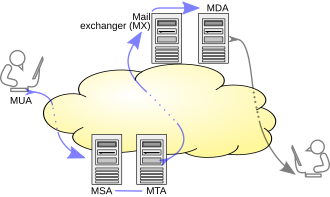Simple Mail Transfer Protocol

Simple Mail Transfer Protocol (SMTP) is an Internet standard for electronic mail (email) transmission. First defined by RFC 821 in 1982, it was last updated in 2008 with RFC 5321, which is the current version of the protocol. SMTP is used to send and receive email messages between mail servers and from email clients to mail servers.
History[edit]
SMTP was developed as part of the ARPANET project, which was the precursor to the modern Internet. It was designed to facilitate the transfer of email messages between different systems. The protocol has evolved over time, with various extensions and updates to improve its functionality and security.
Functionality[edit]
SMTP operates over the Transmission Control Protocol (TCP), typically using port number 25. The protocol follows a client-server model, where the client sends email messages to the server, which then forwards them to the recipient's mail server. SMTP uses a series of commands and responses to facilitate the transfer of messages.
Commands[edit]
Some of the key SMTP commands include:
- HELO or EHLO: Initiates the conversation between the client and server.
- MAIL FROM: Specifies the sender's email address.
- RCPT TO: Specifies the recipient's email address.
- DATA: Indicates the start of the message content.
- QUIT: Terminates the session.
Responses[edit]
SMTP servers respond to commands with numerical codes and text messages. Common response codes include:
- 250: Requested mail action okay, completed.
- 354: Start mail input; end with <CRLF>.<CRLF>.
- 421: Service not available, closing transmission channel.
- 550: Requested action not taken: mailbox unavailable.
Security[edit]
SMTP was not originally designed with security in mind, which has led to various vulnerabilities and issues such as spam and email spoofing. To address these concerns, several extensions and protocols have been developed, including:
- STARTTLS: Provides encryption for SMTP connections.
- SMTP Authentication (SMTP AUTH): Requires users to authenticate before sending email.
- DomainKeys Identified Mail (DKIM) and Sender Policy Framework (SPF): Help verify the authenticity of email messages.
Related Protocols[edit]
SMTP is often used in conjunction with other email protocols, such as:
- Post Office Protocol (POP3): Used by email clients to retrieve messages from a mail server.
- Internet Message Access Protocol (IMAP): Allows email clients to access and manage email messages on a mail server.
See Also[edit]
- Mail server
- Transmission Control Protocol
- Internet standard
- RFC 5321
- STARTTLS
- SMTP Authentication
- DomainKeys Identified Mail
- Sender Policy Framework
- Post Office Protocol
- Internet Message Access Protocol
References[edit]
<references group="" responsive="1"></references>
External Links[edit]
Ad. Transform your life with W8MD's Budget GLP-1 injections from $75


W8MD offers a medical weight loss program to lose weight in Philadelphia. Our physician-supervised medical weight loss provides:
- Weight loss injections in NYC (generic and brand names):
- Zepbound / Mounjaro, Wegovy / Ozempic, Saxenda
- Most insurances accepted or discounted self-pay rates. We will obtain insurance prior authorizations if needed.
- Generic GLP1 weight loss injections from $75 for the starting dose.
- Also offer prescription weight loss medications including Phentermine, Qsymia, Diethylpropion, Contrave etc.
NYC weight loss doctor appointmentsNYC weight loss doctor appointments
Start your NYC weight loss journey today at our NYC medical weight loss and Philadelphia medical weight loss clinics.
- Call 718-946-5500 to lose weight in NYC or for medical weight loss in Philadelphia 215-676-2334.
- Tags:NYC medical weight loss, Philadelphia lose weight Zepbound NYC, Budget GLP1 weight loss injections, Wegovy Philadelphia, Wegovy NYC, Philadelphia medical weight loss, Brookly weight loss and Wegovy NYC
|
WikiMD's Wellness Encyclopedia |
| Let Food Be Thy Medicine Medicine Thy Food - Hippocrates |
Medical Disclaimer: WikiMD is not a substitute for professional medical advice. The information on WikiMD is provided as an information resource only, may be incorrect, outdated or misleading, and is not to be used or relied on for any diagnostic or treatment purposes. Please consult your health care provider before making any healthcare decisions or for guidance about a specific medical condition. WikiMD expressly disclaims responsibility, and shall have no liability, for any damages, loss, injury, or liability whatsoever suffered as a result of your reliance on the information contained in this site. By visiting this site you agree to the foregoing terms and conditions, which may from time to time be changed or supplemented by WikiMD. If you do not agree to the foregoing terms and conditions, you should not enter or use this site. See full disclaimer.
Credits:Most images are courtesy of Wikimedia commons, and templates, categories Wikipedia, licensed under CC BY SA or similar.
Translate this page: - East Asian
中文,
日本,
한국어,
South Asian
हिन्दी,
தமிழ்,
తెలుగు,
Urdu,
ಕನ್ನಡ,
Southeast Asian
Indonesian,
Vietnamese,
Thai,
မြန်မာဘာသာ,
বাংলা
European
español,
Deutsch,
français,
Greek,
português do Brasil,
polski,
română,
русский,
Nederlands,
norsk,
svenska,
suomi,
Italian
Middle Eastern & African
عربى,
Turkish,
Persian,
Hebrew,
Afrikaans,
isiZulu,
Kiswahili,
Other
Bulgarian,
Hungarian,
Czech,
Swedish,
മലയാളം,
मराठी,
ਪੰਜਾਬੀ,
ગુજરાતી,
Portuguese,
Ukrainian